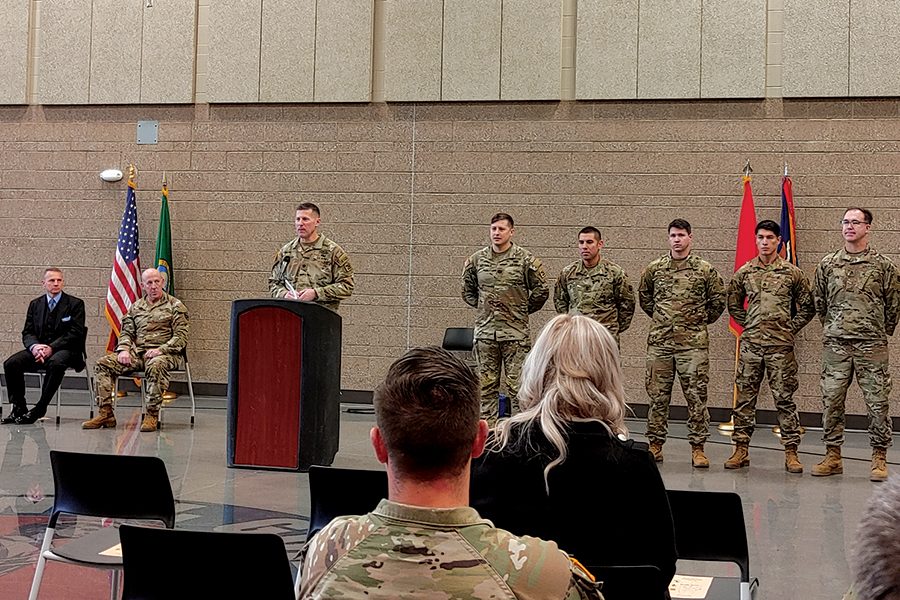
Home » Richland’s new armory throws open doors to National Guard unit
Richland’s new armory throws open doors to National Guard unit

December 13, 2022
The Washington Army National Guard welcomed a 150-member company of soldiers to its $14.2 million Richland Readiness Center on National Pearl Harbor Remembrance Day on Dec. 7.
It took 10 years to conceive, fund and build Richland’s first armory and the first new National Guard facility in Benton County since the Prosser Armory was built in 1947.
It was a memorable undertaking both for the Washington Military Department and for Fowler General Construction, the Richland contractor that built it.
“I’ve never seen a project go as well as this,” said Adam Iwaszuk, director of the construction facilities management office for the military department, who spoke during ribbon cutting ceremonies.
It took just 14 months to build despite the Covid-19 pandemic slowdowns, supply chain issues and other obstacles. He called the process “flawless.”
In the end, the center at 2655 First St. opened on budget and on time. Iwaszuk publicly thanked the contractor.
Brooks Payne, deputy director for Fowler, was clearly moved, saying it is vanishingly rare for a contractor to be thanked for its work in such a public fashion. He said his company was determined to land the project from the moment the state issued a request for proposals.
Once it won the contract, Fowler made sure to overdeliver, he said.
“We knew we wanted to be part of it,” he said, noting Fowler worked under a fixed-price contract.
One example: The 40,000-square-foot building was designed to meet the U.S. Green Building Council’s Leadership in Energy and Environmental Design, or LEED, “silver” criteria, which is required for all state-funded projects. Instead, Fowler delivered a building that is eligible for the council’s higher LEED “gold” standard.
The military department confirmed the Richland building is the first in the National Guard inventory to be on track for LEED gold.
“It is one of the highest performing buildings in the Tri-Cities,” Payne said.
The center is not just efficient. It is a poster child for recruiting soldiers to serve in the Army and Army National Guard, said Brig. Gen. Daniel Dent, commanding general for the state of Washington, who spoke at the ribbon-cutting ceremonies.
The Readiness Center serves as the home base for about 150 soldiers assigned to the 1-161st Infantry Regiment, “Highlanders,” who will travel to Richland to fulfill their commitment to drill one weekend a month and two weeks a year.
The unit is part of a storied organization that traces its history to the mid-1800s when a militia formed to escort Territorial Governor Isaac Stevens from Spokane through The Dalles.
It was federalized in 1898 and has sent soldiers to serve in both World Wars as well as Iraq and to assist in innumerable civil emergencies, from the landslide at Oso to forest fires.
The unit was slated to participate in the planned World War II invasion of Honshu, the main island of Japan. The invasion was called off when Japan surrendered following the bombing of Nagasaki with atomic weaponry developed at the Hanford site in Richland as part of the Manhattan Project.
The military department identified the need for a company facility in 2011 and proposed it two years later.
The Richland Readiness Center was one of a dozen National Guard facilities selected for fiscal year 2020.
The state approved its 25% share in the 2019 capital projects budget and purchased the 40-acre site from the city of Richland ($1.7 million) at about the same time.
Funding is split between the federal and state governments, with $11.4 million in federal funds (through the U.S. Department of Defense) and $3.8 million from the state.
Fowler, the winning bidder, broke ground in 2021. Portland-based TVA Architects was the designer.
The Readiness Center could soon have a neighbor. The military department hopes to use undeveloped land on the property for a second Washington campus for the National Guard Youth Challenge Academy. The first is in Bremerton and cannot accommodate all the demand.
The free academy program serves young men and women who have dropped out of high school or who are at risk of doing so and aims to restore high school credits so they can graduate and succeed as adults. The academy includes a residential component. There are 40 such academies in the U.S.
Real Estate & Construction Local News
KEYWORDS december 2022





